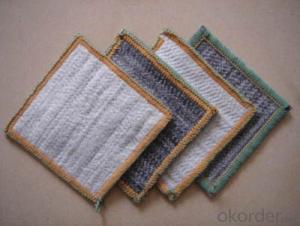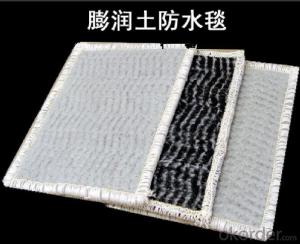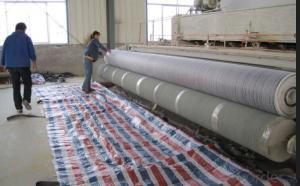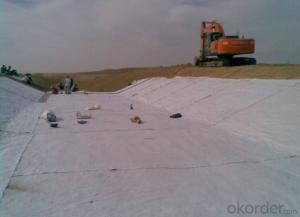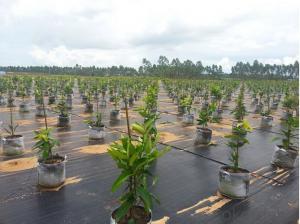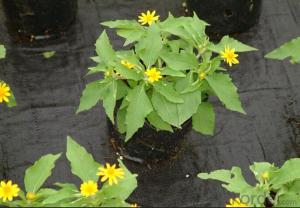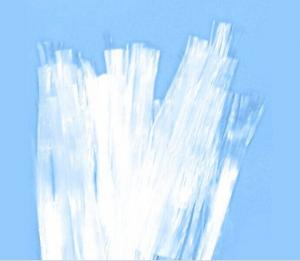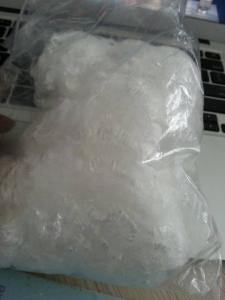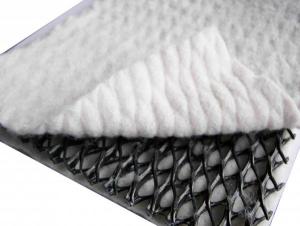Sodium Bentonite Geosynthetic Clay Liner with ASTM Standard
- Loading Port:
- Qingdao
- Payment Terms:
- TT OR LC
- Min Order Qty:
- 5000 m²
- Supply Capability:
- 100000 m²/month
OKorder Service Pledge
OKorder Financial Service
You Might Also Like
Sodium Bentonite Geosynthetic Clay Liner
Introduction of GCL:
Geosynthetic Clay Liner is manufactured
by three levels, including two levels of geotextile whose functions are protecting and strengthen to ensure shearing strength and tensile strength, inner content is Sodium bentonite clay. It is manufactured by nature layer silicate inorganic materials and has high expansibility and high water-absorbing capacity, when soak with low permeable capability, whose the main function is anti-seepage.
Description of GCL
Unit weight ≥4000gsm
width of 4-6m
Compared with clay liner ,it has the advantages of small size,light weight ,good flexibility and sea
easy for construction and suitable for uneven settlement.
GCL Feature:
1.The permanent waterproof
Because sodium base bentonite is a natural inorganic material, even after a long time or the surrounding environment changes,
also won't happen aging or corrosion phenomena, so the waterproof performance persistence.
2. Compactibility
Sodium base bentonite under water pressure condition to form diaphragm with high density, thickness of about 3 mm,
its permeability is 5 x 10-11m/SEC below, equivalent to 100 times the compactness of 30 cm thickness of clay,
have very strong since the water retention performance.
3.Not affected by temperature
In cold climates will not brittle fracture.
4.Environmental protection
Bentonite as natural inorganic material, non-toxic harmless to human body, no special effects to the environment,
have good environmental performance.
5.Simple and short time of construction
Compared to other waterproofing materials, construction is relatively simple, don't need to be heated and paste.
With bentonite powder and nails, washers, etc are connected and fixed. After construction does not need special
inspection, if it is found that the waterproof defects and easy to maintenance.
GCL is existing waterproof material in construction period of the shortest.
Specifications
| Property | National standard | Enterprise Standard | Inspection standards |
| JG/T 193-2006 | |||
| Geosynthetic Clay Expansion index | ≥24 ml/2g | ≥25ml/2g | ASTM D5890 |
| Mass Per Unit Area(g/m2) | ≥4000 g/m2 | ≥4000 gm2 | ASTM D5993 |
| Tensile Strength | ≥6KN/m | ≥8KN/m | ASTM 4632 |
| Maximum load elongation | ≥10% | ≥10% | ASTM 4632 |
| Permeability | ≤5×10-11 | ≤5×10-11 | ASTM D5084 |
| Moisture content | ≤15% | ≤15% | ASTM D4643 |
| Peel strength | ≥40N | ≥65N | ASTM D4632 |
| Hydrostatic pressure | 0.4Mp | 0.4~0.6Mp | ASTM D5891 |
Application of GCL:
Mainly used in environmental engineering or landfill emissions underground reseroirs.underground
infrastructure construction projests sealing solution ,segregation ,anti-leakage,good effect,anti-
destructive
FAQ:
How many quantity for one 20'' container?
About 5,000m2, 16rolls
What's your delivery time?
About 15-20days against deposit received
. What's your package?
Per roll with two pieces woven bag
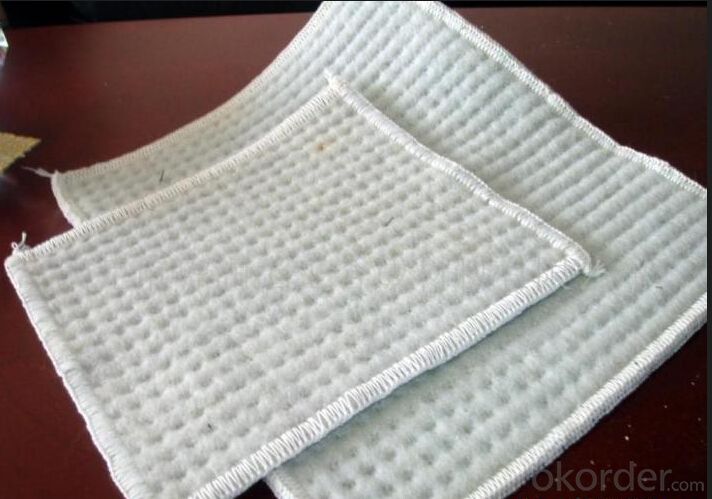
- Q:What are the benefits of using concrete pipes in earthwork?
- There are several benefits of using concrete pipes in earthwork. Firstly, concrete pipes are extremely durable and can withstand heavy loads and harsh environmental conditions. They have a longer lifespan compared to other materials, reducing the need for frequent repairs or replacements. Additionally, concrete pipes are resistant to corrosion, making them ideal for use in underground drainage systems. They also provide excellent flow capacity, ensuring efficient transportation of fluids or materials. Lastly, concrete pipes are relatively cost-effective and easy to install, saving both time and money during construction projects.
- Q:What are the different types of geocell materials available?
- There are various types of geocell materials available, including high-density polyethylene (HDPE), polypropylene (PP), and polyester. These materials offer different strengths, durability, and flexibility properties, making them suitable for different geotechnical applications and project requirements.
- Q:What are the different surface textures available in earthwork products?
- There are several surface textures available in earthwork products, including smooth, textured, brushed, honed, and polished finishes. Each texture offers a unique aesthetic appeal and can be chosen based on personal preference and the desired look for the project.
- Q:How do geocells help in slope protection applications?
- Geocells provide effective slope protection by confining soil and aggregate materials, thus enhancing their stability and resistance to erosion. These three-dimensional honeycomb-like structures prevent soil displacement and retain the materials within the cells, preventing erosion and slope failures. Additionally, geocells can be filled with vegetation or other erosion control materials to further enhance their performance in slope protection applications.
- Q:Can geosynthetics be used for lining fish ponds?
- Yes, geosynthetics can be used for lining fish ponds. They are commonly used as liners in various environmental and agricultural applications, including fish ponds. Geosynthetics provide an effective barrier to prevent seepage and leakage, maintaining water levels and quality in the pond. They are durable, flexible, and resistant to degradation, making them suitable for long-term use in fish pond lining.
- Q:What are the specific applications of geotextile bags in coastal protection projects?
- Geotextile bags are specifically used in coastal protection projects for various applications. They are commonly utilized for shoreline stabilization, erosion control, and beach nourishment. These bags act as a barrier against wave action and currents, preventing further erosion and protecting the coastline. They are also used to create artificial dunes, revetments, and breakwaters, providing additional protection to coastal areas. Geotextile bags are versatile and can be filled with sand, soil, or other materials, allowing for a customized solution based on the project's specific needs.
- Q:Can earthwork products be used for dam construction?
- Yes, earthwork products can be used for dam construction. Earthwork products such as soil, clay, and rocks are commonly used as building materials for dam construction. These materials are used to create embankments, slopes, and foundation structures of the dam, providing stability and strength to the overall structure.
- Q:Are earthwork products resistant to extreme temperature variations?
- Yes, earthwork products are generally resistant to extreme temperature variations due to their natural composition and ability to withstand thermal expansion and contraction.
- Q:How are geotextile tubes used in sediment control during dredging operations?
- Geotextile tubes are commonly used in sediment control during dredging operations by acting as containment structures for the dredged sediment. The tubes are filled with the sediment and the water is allowed to drain out, leaving behind the solid material. This process helps in separating and dewatering the sediment, allowing for the efficient disposal or reuse of the dredged material while minimizing environmental impacts.
- Q:What are the requirements for civil engineering materials?
- Look at the direction of civil engineering ~ road and bridge, housing construction, geotechnical, and now there are tunnels, you see what you need to understand which aspects of technology with the design is not the same ~
1. Manufacturer Overview |
|
|---|---|
| Location | |
| Year Established | |
| Annual Output Value | |
| Main Markets | |
| Company Certifications | |
2. Manufacturer Certificates |
|
|---|---|
| a) Certification Name | |
| Range | |
| Reference | |
| Validity Period | |
3. Manufacturer Capability |
|
|---|---|
| a)Trade Capacity | |
| Nearest Port | |
| Export Percentage | |
| No.of Employees in Trade Department | |
| Language Spoken: | |
| b)Factory Information | |
| Factory Size: | |
| No. of Production Lines | |
| Contract Manufacturing | |
| Product Price Range | |
Send your message to us
Sodium Bentonite Geosynthetic Clay Liner with ASTM Standard
- Loading Port:
- Qingdao
- Payment Terms:
- TT OR LC
- Min Order Qty:
- 5000 m²
- Supply Capability:
- 100000 m²/month
OKorder Service Pledge
OKorder Financial Service
Similar products
New products
Hot products
Hot Searches
Related keywords
